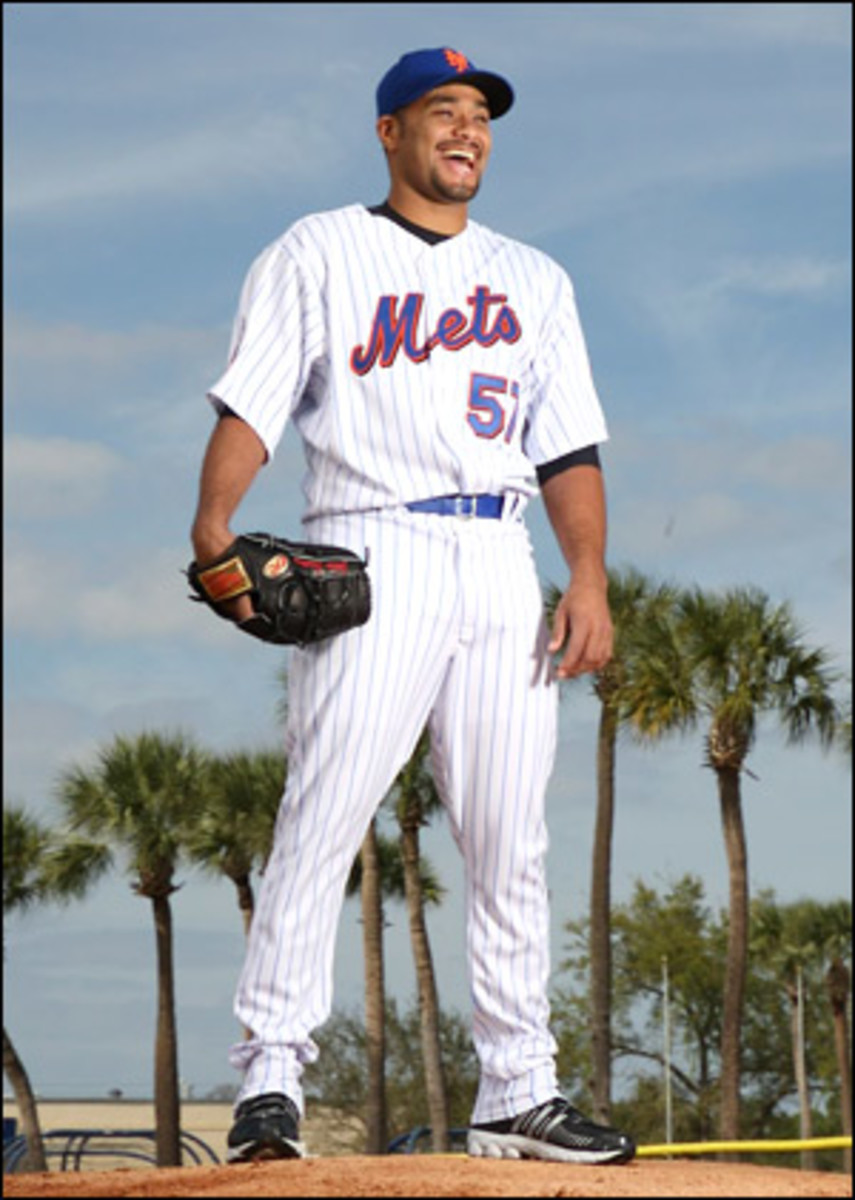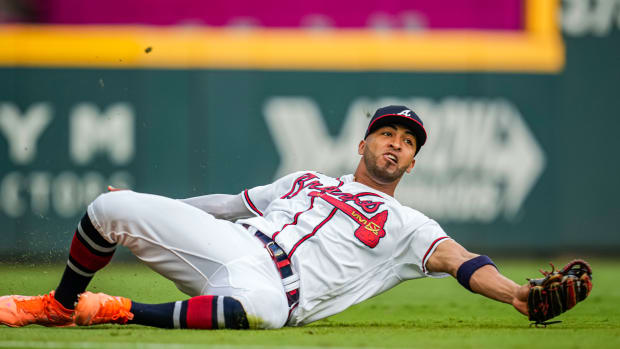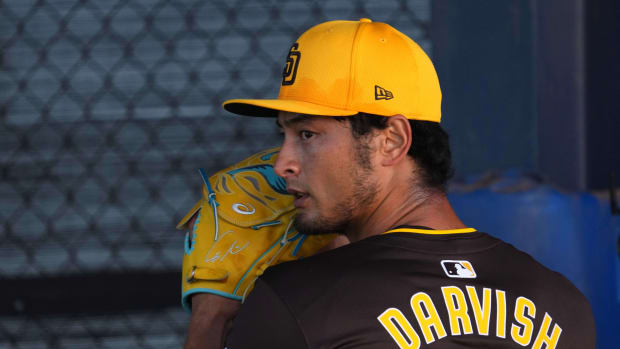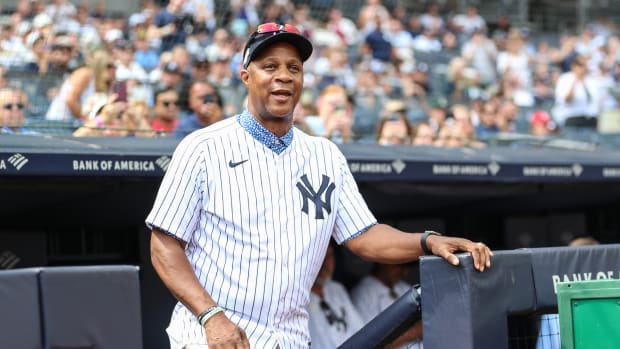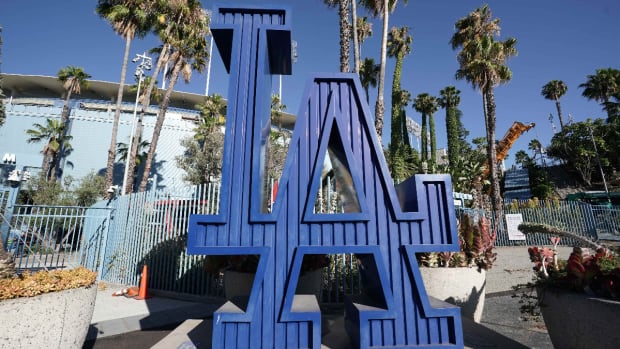The Savior of Port St. Lucie
After the worst week of the worst month in the history of the New York Mets, assistant general manager John Ricco decided it was time for some group therapy. The 39-year-old Ricco is one of those young baseball executives trained to read contracts and prepare arbitration cases. But he also took enough psychology classes at Villanova to know about the different ways people cope with loss.
So, after the Mets blew a seven-game lead with 17 to play last September, Ricco composed a memo for his devastated front-office colleagues entitled "The Five Stages of Grief." With the help of a Google search Ricco typed a description of each stage -- denial, anger, depression, bargaining and acceptance. Then he provided an amateur psychoanalysis of each of his fellow workers, specifying which were stuck in denial and which had moved on to anger, depression or bargaining.
To most Mets executives the memo was artful jest, designed to lighten the mood at a difficult time. But to Jeff Wilpon, the Mets' chief operating officer and the son of principal owner Fred Wilpon, it would prove to be a useful document during a long and therapeutic off-season. Wilpon kept it tucked inside his desk, and he would pull it out to scribble notes in the margins or update the emotional state of his staff.
The memo stayed in Wilpon's desk until Feb. 7, the day after the Mets' introductory press conference for 28-year-old lefthander Johan Santana, whom they acquired from the Minnesota Twins for four prospects and signed to a six-year, $137.5 million contract. To celebrate, Wilpon marched into Ricco's office at Shea Stadium with the memo and said, "You can take this back now. We're moving on. We are starting the five stages of redemption."
Santana, a two-time AL Cy Young Award winner, believes he's coming to New York to headline the Mets starting rotation, ease the burden on their bullpen and hoist the team to its first world championship since 1986. And while all that is true, he was also acquired for another, equally significant reason -- to help the organization move past its historic collapse and ensure that nothing like it ever happens again. "It's like we were on the Titanic and he is our lifeboat," says Mets pitching coach Rick Peterson. "Someone is coming who can rejuvenate us, who can help us heal."
Santana's spring training entrance was inconspicuous by New York standards. When he arrived at the Mets' complex in Port St. Lucie, Fla., on Feb. 13, there was practically no one there to greet him. A tropical storm was soaking the grounds. Most of the players -- and all of the catchers -- were gone for the day. But Santana wanted to work, so Randy Niemann, the rehabilitation pitching coordinator, grabbed a catcher's mitt. Peterson found a dry mound that had been covered by a tarp, and for 15 minutes, as Santana's father, Jesus, napped in his car, the Mets' new ace threw in the rain. "That wasn't rain," Peterson says. "It was healing water."
Given what the Mets endured last fall, they may be a little prone to hyperbole these days. Santana views himself not as a symbol of hope and renewal but as a catalyst for a comeback. He insists that the Philadelphia Phillies are still the favorites to win the National League East this season, while acknowledging that the Mets are uniquely motivated. Riding in a golf cart through the Mets' complex, Santana studied his new surroundings. He stopped at a souvenir stand, already stocked with items featuring his number 57. "I'm not going to go out there and try to be a hero," says Santana, the AL's leader in strikeouts for three of the last four seasons. "I'm just going to be myself. And hopefully, with my help, we can make everyone forget what happened last year."
Santana does not know exactly what happened in September, nor does he need to. He was not around when the Mets made six errors against Philadelphia on Sept. 16, or blew a five-run lead against the Washington Nationals on Sept. 26, or gave up seven runs in the first inning against the Florida Marlins four days later. He was not in the clubhouse that final day, after the Mets' sixth loss in seven games, when manager Willie Randolph was teary-eyed and outfielder Moises Alou was enraged. "I hate baseball right now," Alou said as he cleaned out his locker after the season, a sentiment shared by most of Queens.
For the next four months the Mets tried to recapture their love of the game. Peterson read Eastern philosophy and drew sketches of his players. Third baseman David Wright worked out at Shea Stadium, using bad memories to push through drills. "We have a lot of those memories," Wright says. "They are training tools." General manager Omar Minaya read encouraging notes from friends and commiserated with other G.M.'s, reminding himself that the Mets were not alone in their agony. The San Diego Padres had been one strike away from making the playoffs, when Tony Gwynn Jr. -- of all people -- hit a game-tying triple off Trevor Hoffman to open the door to a key San Diego defeat. Minaya called Padres G.M. Kevin Towers to offer his condolences, but Minaya knew hard work was the only thing that would really help.
The last time the Mets swooned down the stretch, finishing 12-29 in 2004, they reacted swiftly and dramatically. They fired manager Art Howe and demoted G.M. Jim Duquette, hiring Randolph and Minaya and then signing pitcher Pedro Martinez and centerfielder Carlos Beltran. This year, they had to make a similarly drastic move to vanquish the gloom that had descended on the team.
When the Mets' front office convened on Oct. 1 to analyze the breakdown, it was at first unclear if Randolph would be back. But it soon became apparent that they did not need a new manager. Rather, they needed a new starting pitcher, someone who could take the ball with a four-game losing streak and make certain it did not reach five.
Minaya had already spent two years looking for such a stopper. Last off-season he tried to pry Roy Oswalt from the Houston Astros and Carlos Zambrano from the Chicago Cubs. He tried to sign then free agents Daisuke Matsuzaka and Barry Zito. But each time, the Mets either could not swing the deal or did not want to pay the necessary price. This winter only three bona fide aces appeared on the market: Baltimore Orioles lefthander Erik Bedard, Oakland A's righty Dan Haren and Santana.
From the beginning the Mets did not have the prospects to entice Baltimore or Oakland. As the winter meetings opened in Nashville on Dec. 3, Santana was the only attractive option. But if the Twins were going to trade their ace, they wanted at least one established young player in return. The New York Yankees talked about giving up pitcher Phil Hughes, 21, and outfielder Melky Cabrera, 23. The Boston Red Sox discussed dealing either 24-year-old pitcher Jon Lester or 24-year-old outfielder Jacoby Ellsbury. But when the Twins asked the Mets for All-Star shortstop Jose Reyes, also 24, Minaya refused. It was going to be a battle between the Yankees and the Red Sox, as usual.
Still, every time Minaya looked at Minnesota's roster, he saw a match. Having lost Torii Hunter to free agency, the Twins needed a centerfielder, and the Mets could offer 22-year-old Carlos Gomez. The Twins wanted pitching, and the Mets had several prospects. When the meetings ended on Dec. 6 with Santana still on the block, Minaya told Jeff Wilpon, "I think this will come back to us."
"No way," Wilpon said. They settled on a wager. If Minaya could land Santana, Wilpon would buy Minaya a pair of Prada shoes.
On that day, the Yankees agreed to terms on a one-year contract with Andy Pettitte, changing the dynamic of the Santana talks. The Yankees no longer needed a starting pitcher, and the Red Sox no longer needed to worry about blocking the Yankees. "I think you better get your credit card ready," Minaya later told Wilpon.
Minaya may have been confident in private, but he was unusually quiet in public. Mets fans, accustomed to splashy headlines, wondered if their G.M. was still in mourning. But Minaya did not want to raise expectations, fearing more disappointment. As of mid-January it looked as though the Mets' biggest move of the off-season would be a trade with the Nationals for catcher Brian Schneider and outfielder Ryan Church. When Mets closer Billy Wagner took stock of the NL East in November, he picked his team third after the Phillies and the Braves. "I knew we'd do something," Wagner says, "but our guys were under the gun."
Throughout the winter when Randolph would call Peterson, he'd jokingly answer the phone saying, "Did we get Santana?" They both laughed, aware of the long odds. But when Peterson's phone rang in the last week of January, it was Minaya calling with a serious question: "What would Santana mean to our team?"
To find the answer, they had to look back at that horrible stretch in September. In the last 17 games -- 12 of which the Mets lost -- their earned run average was a ghastly 5.96. In the last week they started two rookie pitchers, Philip Humber and Mike Pelfrey. And on the last day, 41-year-old Tom Glavine lasted just a third of an inning against the Marlins, the worst team in the division. The Mets knew what a difference Santana could have made. When he came to Shea Stadium in June, he beat the Mets in a complete-game shutout. "What I remember from that night was his passion and drive," Wright says. "He was determined to finish."
At this point for the Mets, finishing is all that matters. In 2006 they lost Game 7 of the National League Championship Series to the St. Louis Cardinals. In 2007 they started 22-12, and then played on autopilot for four months. "We didn't show up," Wagner says. "It was overconfidence. It was us saying, 'We're good, we'll get in the playoffs, we'll win.' "
The Mets needed Santana, and he needed the Mets. By the end of January both parties were getting anxious. Through his agent, Peter Greenberg, Santana told the Twins that he wanted to be traded by Jan. 29. Otherwise, he could exercise his no-trade clause, play out the season in Minnesota and leave as a free agent afterward. On the night of Jan. 27, at the annual New York baseball writers dinner, Minaya told Wilpon that the Twins were looking for a final offer. The Mets had agreed to give up Gomez, Humber and pitching prospect Kevin Mulvey, 22. Then New York decided to throw in another pitching prospect, Deolis Guerra, an 18-year-old righthander from Venezuela. It was Guerra who made the package complete.
But Minaya would have to wait to get his shoes. The Mets had a 72-hour window in which to negotiate a contract extension with Santana, and after those 72 hours were up, Santana was still sticking to his asking price: $140 million. The Mets were offering $135 million. Santana was sitting at the negotiating table, prepared to reject the Mets' offer and go back to Minnesota, however uncomfortable it might be.
The Mets could not let that happen, not after what had occurred in September. In the past they've had great success recruiting players face-to-face. They went to the Dominican Republic to court Martinez. They went to Puerto Rico to woo Beltran. Now they flew Santana from his home in Fort Myers, Fla., to the team's corporate offices in Rockefeller Center.
Wilpon gave Santana his best pitch. "I explained that we are a family business, that we are not going anywhere, and that we are not done improving this team," Wilpon says. After the Mets requested and received a two-hour extension to negotiate, Santana agreed to a compromise: $137.5 million. The deal, two months in the making, was done. The Venezuelan pitcher was in New York for good.
Just like that the Mets went from stragglers to favorites. When Randolph called his players before spring training, he could hear the excitement in their voices. "You can't forget what happened [last season]," Randolph says. "It will always be there. But this is a chance to redeem yourself. . . . I love the fact that we can dispel some of that hurt and pain." Even Beltran, usually quiet and diplomatic, is making guarantees. A year after Phillies shortstop Jimmy Rollins declared that Philadelphia was the team to beat in the NL East, Beltran responded in kind. "Without Santana, we felt we had a chance to win our division," he says. "With him, I have no doubt. So this year, to Jimmy Rollins, we are the team to beat."
Of course, the Mets have another Cy Young Award winner from Latin America, and it is hard to tell how he will react to the new order. Martinez still views himself as an ace, and when the Red Sox made him their de facto No. 2 starter behind Curt Schilling in 2004, he did not exactly take the demotion gracefully.
But Martinez is 36 now, coming off a season of injuries, finally confronted with his baseball mortality. He needs all the help the Mets can offer him. "I can breathe now," Martinez says. "This is like getting a big glass of cold water when you're really thirsty." It probably helps that Santana has shown Martinez the proper deference in the past. Two years ago Santana sought out Martinez and asked him for his autograph.
Initial reviews of the trade favored the Mets. But before anyone dismisses the Twins as another plundered small-market team, remember how many of these deals have worked out in their favor. In 1989 they sent veteran lefty Frank Viola to the Mets for a package that included Rick Aguilera and Kevin Tapani, both of whom helped pitch the Twins to a World Series victory two years later. In 1998 Minnesota sent second baseman Chuck Knoblauch to the Yankees for a package that included lefthander Eric Milton and shortstop Cristian Guzman, who helped the Twins win three straight American League Central titles beginning in 2002. And in 2003 they sent catcher A.J. Pierzynski to San Francisco for young pitchers Joe Nathan, Francisco Liriano and Boof Bonser, a mind-staggering steal. "We've been down this road before," says Twins president Dave St. Peter, "and based on that history, we have great confidence."
While both sides profess their happiness with the deal, Wilpon still had one more piece of business to attend to when it was complete. He drove to Richards, a clothing store near his home in Greenwich, Conn. He ordered a pair of black Prada lace ups and had them shipped to Port St. Lucie. When Minaya arrived at spring training, the shoes were waiting for him.
Right now, everything about the Mets looks polished and shiny. No one can imagine them starting this season the way they finished the last one. That is the seductive power of spring, and of Santana. Without throwing a single pitch to a batter, he has already delivered his new team to the all-important fifth stage of grief: Acceptance.






























